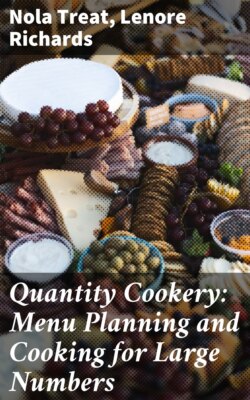Читать книгу Quantity Cookery: Menu Planning and Cooking for Large Numbers - Lenore Richards - Страница 7
На сайте Литреса книга снята с продажи.
STANDARDS FOR JUDGING MEALS
ОглавлениеTable of Contents
Provided the principles of good nutrition have not been violated, the main basis for judging any meal is palatability. Palatability depends upon appearance and quality. Appearance in turn depends upon quantity, color, form and service upon the plate. Quality is determined by odor, flavor, temperature, texture and consistency. Reduced to outline form, the elements of palatability are:
| quantity color form neatness arrangement | ||||
| appearance | ||||
| Palatability | ||||
| quality | odor temperature flavor texture consistency | |||
Commercially and aesthetically it is unwise to make servings too large. Every one has had the experience of being served with more food than can be eaten with relish and without waste. The effect is to surfeit the appetite and to limit the variety which a patron may have, unless he is able financially to order the variety; in which case he is obliged to leave some food uneaten. In any institution which serves à la carte, it is better to adjust portions and prices to the end that the patron may have some variety in his meal without prohibitive expense.
Color is important in inducing appetite. The cafeteria counter displaying a buff-colored pie, snow pudding, rice custard and yellow cake does not tempt patrons to buy. A basket of fruit, a bright-colored gelatin dessert or attractive garnishes may transform a drab meal into a most interesting one. Particularly in all kinds of plate service, attention must be paid to color, for while clashing color combinations must be avoided, some color must be used to give the food an appetizing appearance. A great deal of our food is very neutral in color and admits of a liberal use of garnishes of one kind or another.
As a rule articles of food served together should be of diverse shapes. One may enjoy a croquette, a stuffed baked potato, peas in timbales and a roll in the same meal, but it is usually unwise to serve them on the same plate.
The necessity for neatness and orderly arrangement of servings is obvious. At large parties where there is plate service it is wise to make up a sample plate before the time of serving in order to determine the best arrangement of food and in order actually to show those who are to dish up the food how each plate must look when it is placed before the guest. One who is inexperienced in planning menus, especially for parties, should accustom himself to visualizing the meal as it will appear when written upon the menu card and as it will appear upon the plate. A menu which has seemed very good when planned will often be unsatisfactory when actually served because some of the above points have been overlooked.
Odor and temperature are important factors in quality. It would seem superfluous to say that hot things must be served hot and cold things must be served cold, yet in serving large numbers the strict observance of these rules is one of the difficult problems to be solved. It can be solved, however, with efficient equipment properly arranged, a carefully thought out organization of service and unceasing care.
Repetition of texture and consistency should also be avoided. That is to say, there should be the maximum variety in preparation of food in order that no meal shall contain two or more creamed dishes, fried foods, foods with custard basis or foods with bread foundation.
If a score card were made out for judging a meal, flavor would perhaps be given the most importance. Here again care must be taken to avoid duplicating flavors. Too many strong flavors or too many bland flavors are undesirable. While strong flavors stimulate the appetite it is unwise to employ them continually, especially where the same group of people is being served day after day. A more blandly flavored diet is likely to be less palling and more constantly inviting.
In serving the public, whether it be in the hospital, the college dormitory or the commercial restaurant, the aim should always be to have the food better than that to which the patrons are accustomed.
In almost any kind of food work, and especially in institutional food work, visiting trips to the best hotels, tea rooms, inns, cafeterias and restaurants are invaluable, since they impart a knowledge of the way things are done, which in turn creates a confidence and assurance that nothing else can give.
